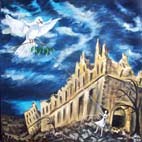New Zealand artists will be exhibiting in an exhibition for peace and remembrance in Cassino, Italy, 15 - 29 May 2010. The venue is the Pietromalatesta rooms, Bibilioteca Comunale, in central Cassino, and the exhibition will be hosted by the Cassino Comune.
Here, in tourist destination Italy, I live in a country that was destroyed. The battle front stayed in this area for 5 months. It is unthinkable how the people suffered, and still do live with this history in their daily lives. I see museums showing the military side of things, the strategies, the equipment, but it is the photos and stories of emotional pain and suffering that touches me most.
I work as a volunteer with visiting veterans groups, with memorial museums and as a battlefield tour guide. Many veterans share their stories, and all say sorrowfully that we must never let such events happen again. To share time with these old soldiers, and then see what is happening still all over the world, leaves me feeling that I must try to do something, however insignificant it might seem.
I see curating an exhibition with peace and commemoration as a theme as a way of passing on the message from the veterans that I meet, that war must end. I also see it as a great opportunity for NZ artists to exhibit in Italy. I appreciate that side of it as I had a similar chance in 2005, but more important to me is keeping the peace message alive.
We see Anzac Day parades growing in strength. I believe the time is right for artists to reinforce the peace messages coming from the soldiers who fought in this battle. I think that artists have a responsibility to reflect what is happening in society, and in fact they do that whether they are conscious of it or not. The immeasurable, unrecorded history is that of the returned soldiers, the waiting families, the changed lives in far away New Zealand.
How far did the events in Europe ripple through our culture, contributing to the society we have now? What effect did the trauma of battle have on the young men returning home to families who could not begin to understand what they had been through? What was the effect of the waiting, the pain of loss, on the families that remained behind? If giving artists this opportunity gets them talking to their family and friends then I think that the movement towards peace has already become stronger, and this movement will be recorded in their future works.
If we all do a tiny part in a move towards international peace we must eventually reach a tipping point where we can change nations and governments. One British veteran talks about "pax in spinus" (peace from thorns) and I see that as being appropriate here. If we let this continue, never learning, then there is no sense in sending soldiers out believing that they are contributing to peace. While I believe that no war ever brought real peace, we can't ignore what has happened either. Peace comes from a different place, but war history and commemoration is a place where we can start to talk about peace.
Cassino was completely destroyed and is recognised as a martyr city. It has a lasting place in New Zealand history, so where better place is there to call NZ artists together to work for peace? It is my hope that these artists will continue to learn more about what happened here, and in other places, and continue to produce works that further the work of peace movements throughout the world.
Subscribe to:
Post Comments (Atom)












No comments:
Post a Comment